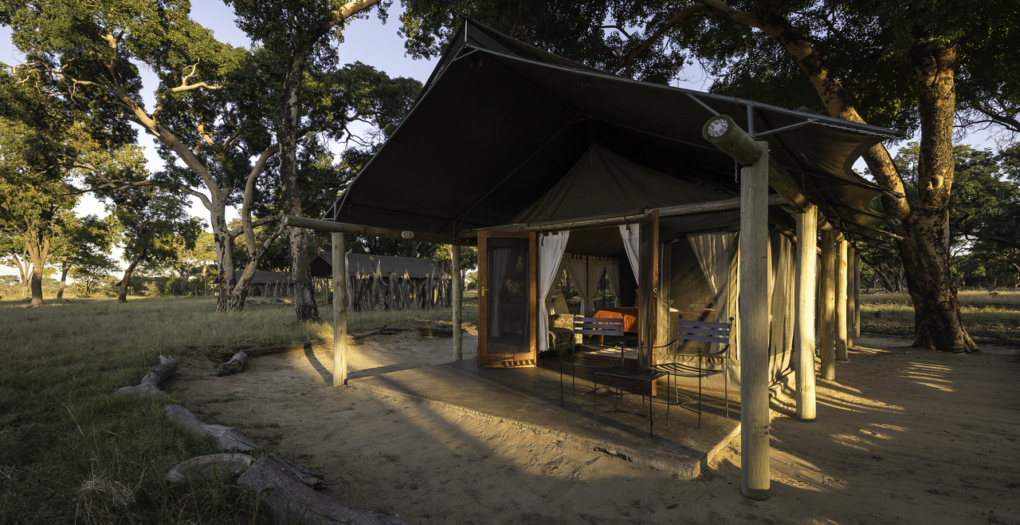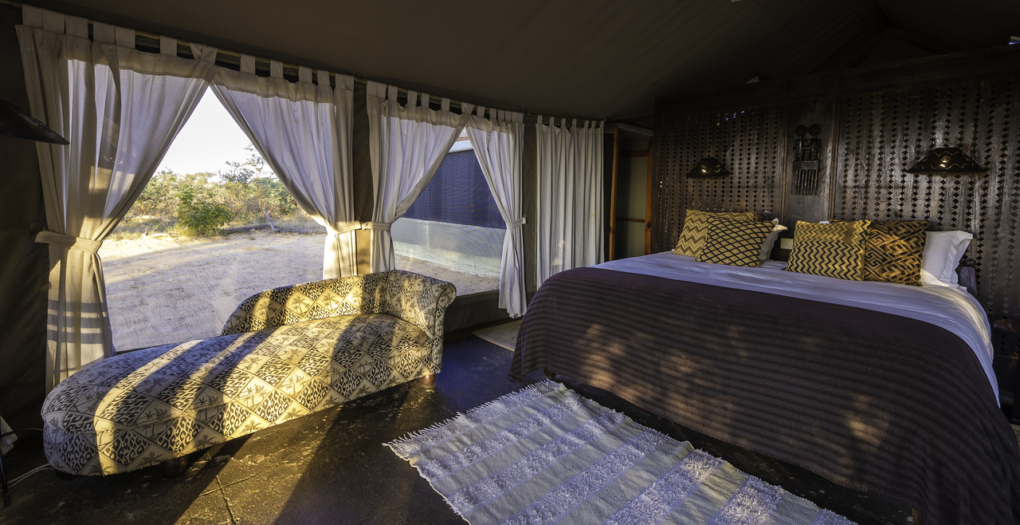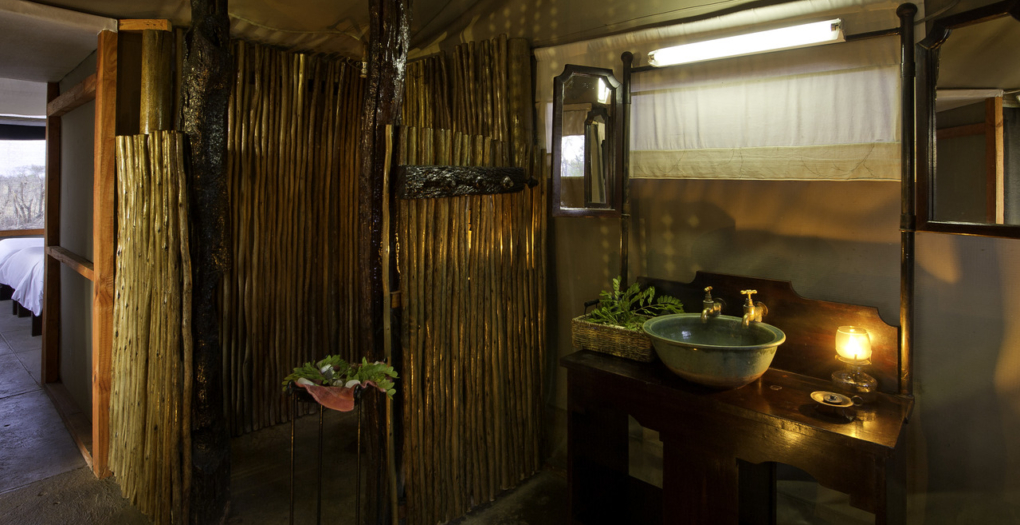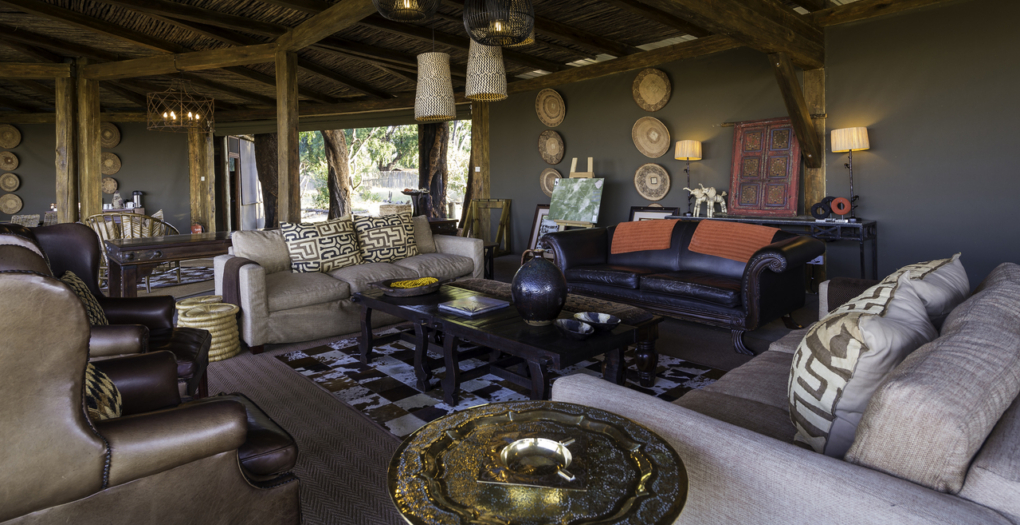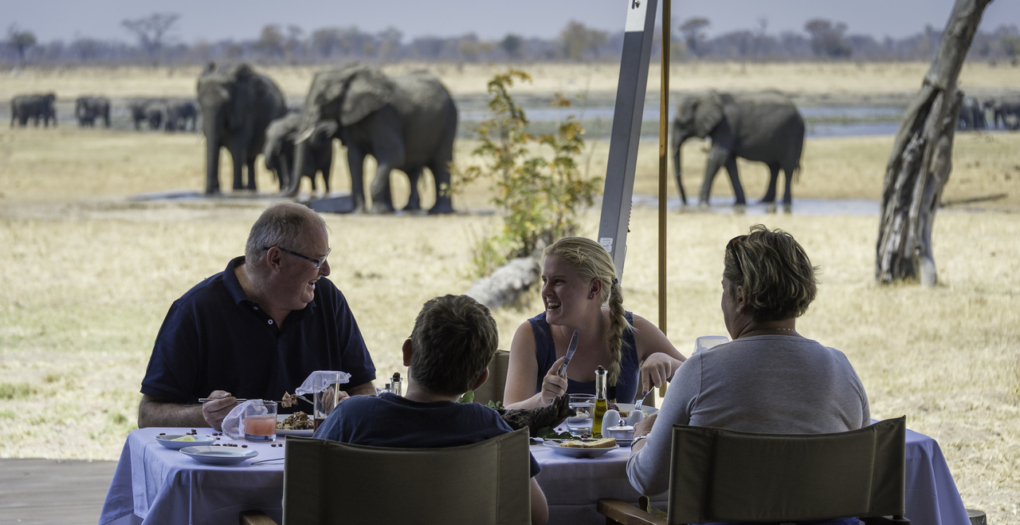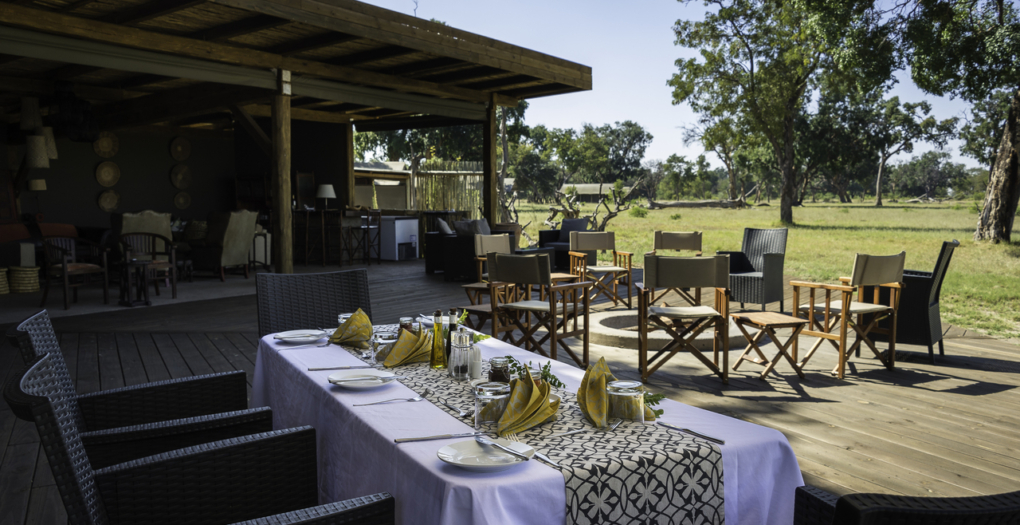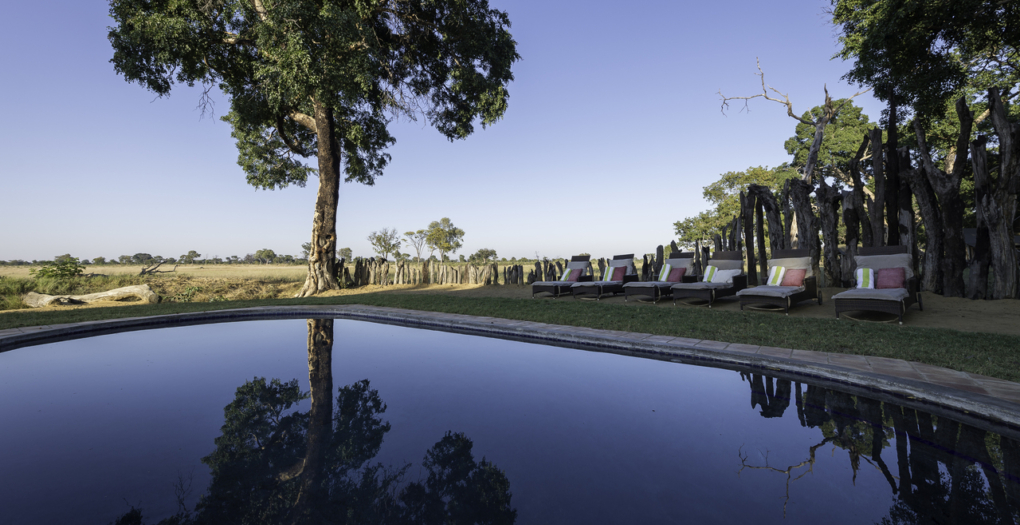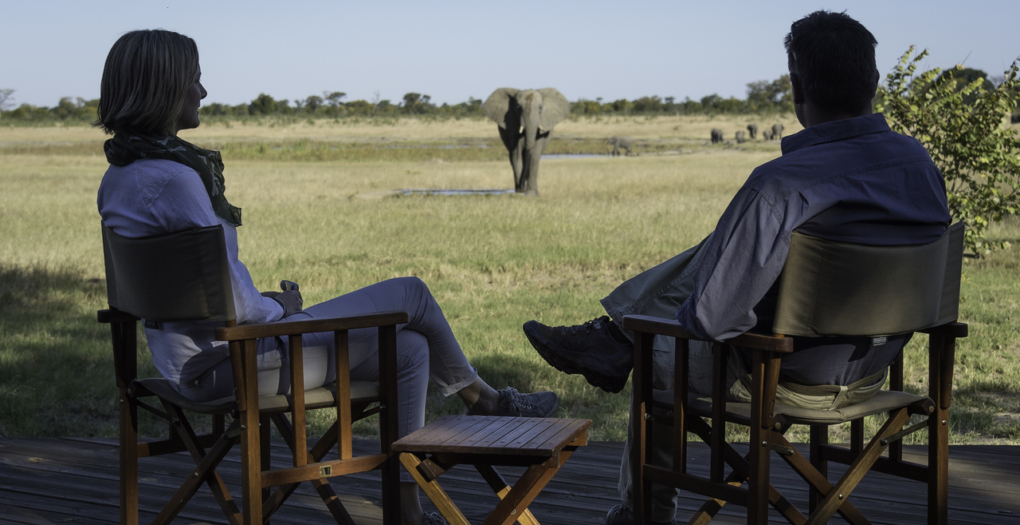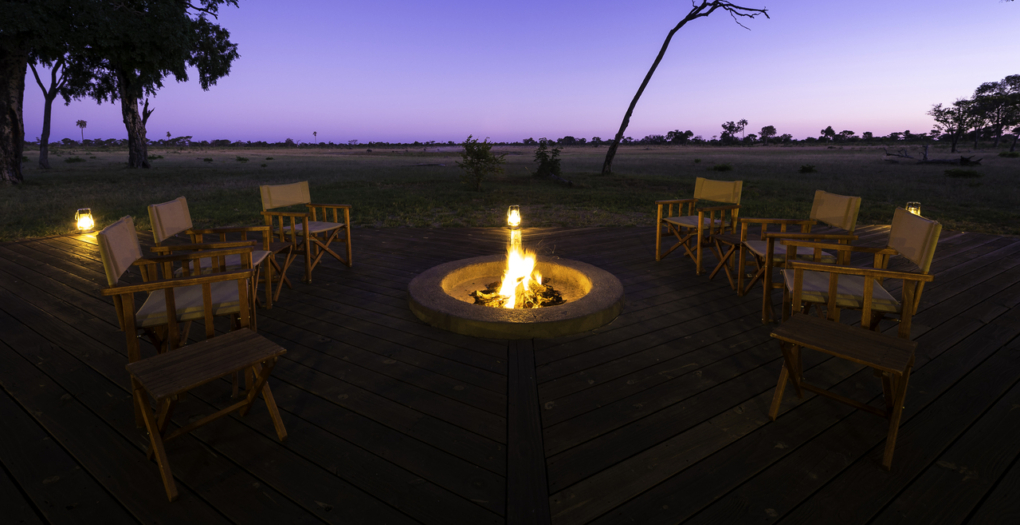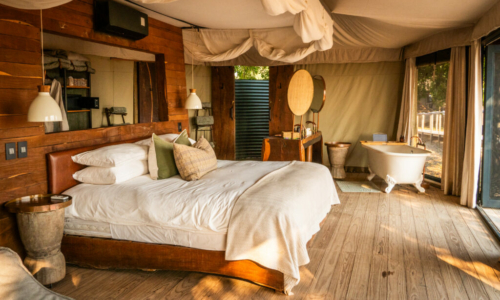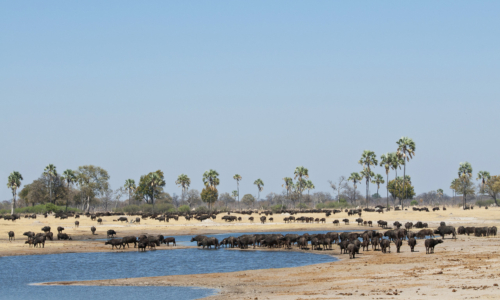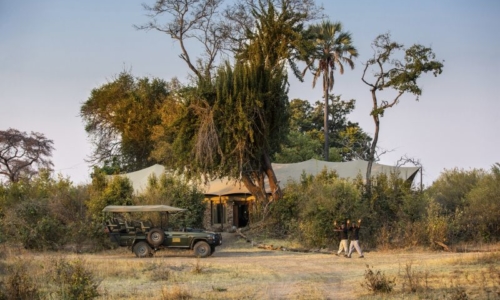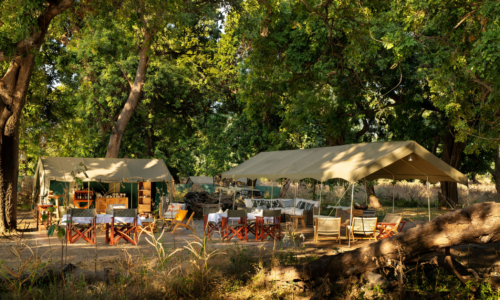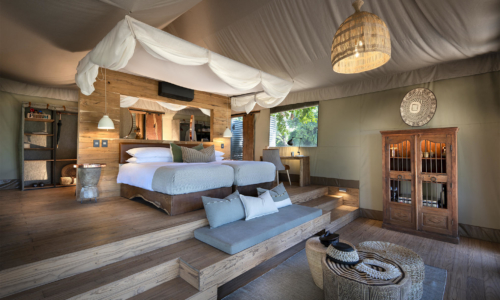Named after Ted Davison, Hwange National Park’s first game warden, this classic camp offers a unique bush experience. Accommodations at the camp consist of nine Meru-style tents including one family tent. Six of the rooms come with two-twin beds and two have double beds. The en suite bathroom features a flush toilet, sink, and a shower. The family tent has two en suite bedrooms with a shared entrance. The master bedroom has a king-sized bed and the second bedroom comes with two twin beds.
The camp is located in the Hwange National Park, Zimbabwe’s largest and most popular national park. The vegetation across the park vary hugely, ranging from the semi desert scrub on the edge of the Kalahari in the south, to forests, granite hills, and valleys of mopane woodlands in the north. There is an abundance of wildlife found in the park year-round including lion, buffalo, cheetah leopard, spotted hyena, cheetah, giraffe, sable, roan, blue wildebeest, impala, waterbuck and reedbuck. Hwange is known for its large population of elephants. Historically, the area was home to a significant number of San Bushmen people. Two important conservation and research projects are operated within the Park: The National Leopard Project and the Painted Dog Project so as to track and increase the numbers over the years.
Game drives are conducted in open Land Rovers by expert guides and trackers through both the private concession and Hwange. Morning walking safaris led by a knowledgeable guide are the best way to see the landscape in detail and view any smaller flora or fauna missed by the vehicles. Night drives discover the nocturnal world of lesser bush baby, spotted hyena, leopard, lion, Selous mongoose, pangolin, caracal, porcupine, scrub hare, springhare, and even honey badger. Cultural visits travel to the local villages for a guided tour of the school, meeting the headman or headwoman, and enjoying cultural exchanges with the villagers. A bird watcher’s paradise, there are over 400 bird species in the park.
The camp overlooks a busy waterhole that attracts both plains game and their predators. The main area houses a lounge, dining room, and an expansive viewing deck. At night, guests gather around the fire pit on the open deck for a drink and a chance to discuss the day’s adventures. The camp has a refreshing pool and loungers for relaxing during the afternoon.


- Amalinda Lodge
- Bumi Hills Safari Lodge
- Camp Hwange
- Changa Safari Camp
- Chikwenya
- Davison’s Camp
- Deteema Springs
- Ingwe Pan
- Kanga Expeditions
- Linkwasha Camp
- Little Makalolo
- Little Ruckomechi
- Little Vundu
- Mana River Camp
- Matetsi Victoria Falls
- Mpala Jena Camp
- Muddy Teak
- Nyamatusi Camp
- Nyamatusi Mahogany
- Old Drift Lodge
- Pamushana Lodge
- Ruckomechi Camp
- Somalisa Acacia
- Somalisa Camp
- Somalisa Expeditions
- Tembo Plains
- The Elephant Camp
- The Hide
- Verney’s Camp
- Vundu Camp
- Zambezi Expeditions
- Amalinda Lodge
- Bumi Hills Safari Lodge
- Camp Hwange
- Changa Safari Camp
- Chikwenya
- Davison’s Camp
- Deteema Springs
- Ingwe Pan
- Kanga Expeditions
- Linkwasha Camp
- Little Makalolo
- Little Ruckomechi
- Little Vundu
- Mana River Camp
- Matetsi Victoria Falls
- Mpala Jena Camp
- Muddy Teak
- Nyamatusi Camp
- Nyamatusi Mahogany
- Old Drift Lodge
- Pamushana Lodge
- Ruckomechi Camp
- Somalisa Acacia
- Somalisa Camp
- Somalisa Expeditions
- Tembo Plains
- The Elephant Camp
- The Hide
- Verney’s Camp
- Vundu Camp
- Zambezi Expeditions

Named after Ted Davison, Hwange National Park’s first game warden, this classic camp offers a unique bush experience. Accommodations at the camp consist of nine Meru-style tents including one family tent. Six of the rooms come with two-twin beds and two have double beds. The en suite bathroom features a flush toilet, sink, and a shower. The family tent has two en suite bedrooms with a shared entrance. The master bedroom has a king-sized bed and the second bedroom comes with two twin beds.
The camp is located in the Hwange National Park, Zimbabwe’s largest and most popular national park. The vegetation across the park vary hugely, ranging from the semi desert scrub on the edge of the Kalahari in the south, to forests, granite hills, and valleys of mopane woodlands in the north. There is an abundance of wildlife found in the park year-round including lion, buffalo, cheetah leopard, spotted hyena, cheetah, giraffe, sable, roan, blue wildebeest, impala, waterbuck and reedbuck. Hwange is known for its large population of elephants. Historically, the area was home to a significant number of San Bushmen people. Two important conservation and research projects are operated within the Park: The National Leopard Project and the Painted Dog Project so as to track and increase the numbers over the years.
Game drives are conducted in open Land Rovers by expert guides and trackers through both the private concession and Hwange. Morning walking safaris led by a knowledgeable guide are the best way to see the landscape in detail and view any smaller flora or fauna missed by the vehicles. Night drives discover the nocturnal world of lesser bush baby, spotted hyena, leopard, lion, Selous mongoose, pangolin, caracal, porcupine, scrub hare, springhare, and even honey badger. Cultural visits travel to the local villages for a guided tour of the school, meeting the headman or headwoman, and enjoying cultural exchanges with the villagers. A bird watcher’s paradise, there are over 400 bird species in the park.
The camp overlooks a busy waterhole that attracts both plains game and their predators. The main area houses a lounge, dining room, and an expansive viewing deck. At night, guests gather around the fire pit on the open deck for a drink and a chance to discuss the day’s adventures. The camp has a refreshing pool and loungers for relaxing during the afternoon.

- Amalinda Lodge
- Bumi Hills Safari Lodge
- Camp Hwange
- Changa Safari Camp
- Chikwenya
- Davison’s Camp
- Deteema Springs
- Ingwe Pan
- Kanga Expeditions
- Linkwasha Camp
- Little Makalolo
- Little Ruckomechi
- Little Vundu
- Mana River Camp
- Matetsi Victoria Falls
- Mpala Jena Camp
- Muddy Teak
- Nyamatusi Camp
- Nyamatusi Mahogany
- Old Drift Lodge
- Pamushana Lodge
- Ruckomechi Camp
- Somalisa Acacia
- Somalisa Camp
- Somalisa Expeditions
- Tembo Plains
- The Elephant Camp
- The Hide
- Verney’s Camp
- Vundu Camp
- Zambezi Expeditions
- Amalinda Lodge
- Bumi Hills Safari Lodge
- Camp Hwange
- Changa Safari Camp
- Chikwenya
- Davison’s Camp
- Deteema Springs
- Ingwe Pan
- Kanga Expeditions
- Linkwasha Camp
- Little Makalolo
- Little Ruckomechi
- Little Vundu
- Mana River Camp
- Matetsi Victoria Falls
- Mpala Jena Camp
- Muddy Teak
- Nyamatusi Camp
- Nyamatusi Mahogany
- Old Drift Lodge
- Pamushana Lodge
- Ruckomechi Camp
- Somalisa Acacia
- Somalisa Camp
- Somalisa Expeditions
- Tembo Plains
- The Elephant Camp
- The Hide
- Verney’s Camp
- Vundu Camp
- Zambezi Expeditions







